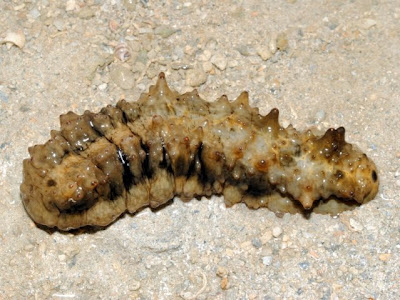This is my third consecutive trip on the shore that I've been guiding with students from schools. First was at Sentosa with DHS, second at St John's Island with TJC and this time to Semakau!
With me today is a group of guys (and Ms Ho) from Victoria School! We belong to the group Seagrass. Of course, the best place for us to take a whacky group photo will be in the middle of the seagrass meadow.
Our group had a request to see the horseshoe crab and I was not confident to tell him that we will see it today. But hey, a student from another group found this Mangrove horseshoe crab (Carcinoscopius rotundicauda)! In case you don't know, the blood of horseshoe crabs is able to detect bacteria in human medication.
There were many different species of sponges on the shore and here's two of them.
The hunter seekers found a lovely pair of juvenile Noble volute (Cymbiola nobilis).
According to the Singapore Red Data Book, this beautiful snail is restricted to our part of the world, in particular, Singapore and Peninsular Malaysia!
There were quite a number of sea cucumbers sighted today. This first one that looks more like a snake or a long worm is actually the Synaptic sea cumuber.
While this species of sea cucumber is more commonly found not only on our shores but also on the dinner plates of people during Chinese New Year. This is the Garlic bread sea cucumber (Holothuria scabra) which is sometimes also known as sandfish sea cucumber.
This Stonefish sea cucumber (Actinopyga lecanora) is yet another species of sea cucumber that is edible. Supposedly, this species of sea cucumber is much cheaper than the sandfish sea cucumber. I have never eaten this before.
The last sea cucumber species will be this Dragonfish sea cucumber (Stichopus horrens). This is one of the sea cucumbers whose body fluids are harvested in Malaysia for 'Air Gamat', a local health tonic that believed to aid healing and other ailments.
Moving on from sea cucumbers, the sea stars are relatives that belong to the same phylum- Echinodermata. Here we have a four-armed male Common sea star (Archaster typicus) interlocking the arms of the female in their act of external fertilisation (of eggs and sperms in the water).
Thanks to Jiayi's hunter seeking, we could have a look at this lovely Cushion star (Culcita novaeguinea). It does not really look like a sea star from the top.
But when you flip it around, you can see the five grooves of tube feet which are representative of sea stars. I like the orange colour of this cushion star's underside!
And of course, a semakau guided walk will not be complete without the charismatic Knobbly sea stars (Protoreaster nodosus)- a great moment for another group photo.
The top find of the day will be this Purple-spotted yellow flatworm (Pseudoceros laingensis) that I've been always wanting to see. Therefore, I was thrilled to see it for the first time.
Today's trip was a great one with lovely cool weather after the predawn rain. The students were attentive audience and they enjoyed the trip! May this trip be a beginning for them to be more aware and involved towards conserving our own natural heritage.
More photos of the trip here: http://www.flickr.com/photos/koksheng/archives/date-taken/2011/04/10/
Sunday, April 10, 2011
Semakau shore with Victoria School students
Subscribe to:
Post Comments (Atom)


















No comments:
Post a Comment